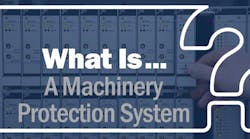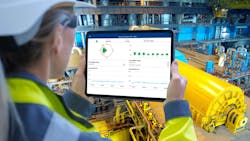A machinery protection system is a technology, often rack-mounted, that connects directly to assets in the field to ensure they shut down rapidly and safely in the event of a critical abnormality in operation. Using sensors connected to the asset, the machinery protection system monitors operational variables, and it executes a shutdown procedure when those variables reach specific thresholds that indicate a critical failure (Figure 1).
Machinery protection systems have been in use for decades, though modern systems offer significantly improved capability over legacy solutions.
Modern features of today’s machinery protection systems drive better protection
With time comes improvement, and machinery protection systems are no exception. While modern systems offer the same or improved level of protection as systems from decades ago, many of the most advanced systems also offer additional features to improve reliability, safety, and efficiency.
Modern machinery protection systems offer cybersecure remote monitoring and operation, improved visibility, lower cost of operation over the lifecycle of the equipment, and powerful predictive maintenance features to help teams intervene before asset problems become equipment failures.
Improved visibility. Legacy protection systems were typically designed as standalone systems. They were installed and connected either directly to the machine they protected or to the control system. There was no direct interaction with the system by operators, no access to live data or remote access to the system, and no visualization via software. As a result, reliability teams had limited to no visibility into how well the system was working once it was installed.
Modern machinery protection systems offer significantly increased visibility. Not only do they provide data about the machines they are monitoring, they also provide self-diagnostics. As a result, the best teams no longer set-and-forget their machinery protection systems, but they instead monitor them to ensure they are operating as expected.
The most advanced systems simplify this monitoring with remote connectivity via mobile apps. The apps offer cybersecure, view-only connectivity. Users cannot change settings, but they can see live data, the status of every channel, and the current setpoints on their equipment (see Figure 2).
Lower total cost of ownership. The most effective modern machinery protection systems provide lower total cost of ownership through digitalization. Where legacy systems were often filled with a dozen or more single use cards for sensors, modern solutions need only a small number of digitally-configured, multi-use cards, and each can be configured as needed. Not only does such a solution simplify installation and configuration, it also reduces the number of spare parts a team needs to keep in supply to ensure their critical equipment will not need to be shut down.
Similarly, modern systems also offer improved solutions for the sensor chain. Eddy current sensors used with protection systems come in hundreds of different combinations of size, length, and other variables, all of which are calibrated differently. Traditionally, a team wanting to maintain spares for eddy current sensors needed to have a significant inventory of parts in supply. Today, however, advanced machinery protection systems use digital sensor converters that can be calibrated to match any type of sensor, enabling them to dramatically reduce required spares on-hand.
Prediction plus protection. Historically, when a machinery protection system shut down equipment, a company could face significant lost production while the reliability team spent valuable time performing an investigation into why the equipment shut down and whether they could bring it back online. Today, prediction software built into protection systems tracks and trends the health of critical assets, providing essential insights into why equipment failed.
Even more importantly, however, those same prediction systems also track and trend asset health across time, enabling reliability teams to see when conditions are starting to degrade long before they lead to failure. Often, teams can use this critical data to intervene well before the protection system does.
Proven, but modern, solutions
Historically, there were few suitable protection systems that would meet critical asset monitoring and protection needs. Today, however, reliability teams not only have more choice in machinery protection systems today than they did decades ago, they also have multiple choices with a long history of proven protection. These teams are no longer locked into a single provider, nor must they settle for new, unproven systems to capture all the modern features they desire. It is possible to upgrade to a solution that has modern features and demonstrates a legacy of successful protection across decades in the field.
Ultimately, those teams will be best served by choosing an established system with many years of proven success, but one that has also been continuously updated to provide all the modern technology they need for efficient, convenient, and safe operations.


